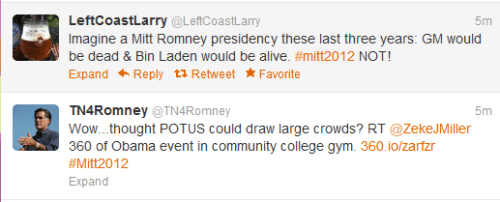Ty Green recently joined the staff of Breaking Even Communications. While an avid Facebook user and online reader, he didn’t use Twitter much…. until starting his Breaking Even gig. Below is his story where Ty found himself following the current presidental campaigns more closely than he ever thought possible.
As a new Twitter user getting accustomed to the range of uses and approaches the site affords, I am perhaps especially sensitive to trends in the way different types of people and organizations use Twitter.
Like many starting out on Twitter, I randomly selected a wide range of accounts to follow: news media, local businesses, friends, celebrities, publications and politicians. Within hours, I began to notice the frequency with which the political candidates’ accounts pumped out new Tweets, little updates, rebuttals, extra bits of spin.
After a few days of observing the rhythms of Twitter, I found that these political candidate accounts are by far the most constantly updated. Businesses and celebrities, even the average Twitter user, may Tweet once or twice a day, maybe a little more if there was some topic of particular relevance to the individual or company in question.
The only other type of Twitter account with updates as frequent — indeed, as seemingly constant — as the politicians’ was news media, especially the big wire services like Reuters and the Associated Press. I was immediately struck by the relationship between these two, and the realization that the relentless onslaught of information from these news sources was exactly why political campaigns hardly had a moment to breathe between Tweets.
The contemporary news cycle is so ceaselessly churning that the contemporary candidate has no choice but to have his staff keep up with social media, lest he or she appear out of touch with the marketing, advertising and communication opportunities of the 21st century.
That got me thinking about the price tag. This is the most direct contact a politician (or campaign staff) can have with voters or constituents outside of actual face time, and it doesn’t cost a penny. Via Twitter, political campaigns can now have direct, real-time conversations with their followers, who could number in the thousands or even in the millions. It’s a strange concept, supremely public yet not without an element of intimacy unavailable to the candidates and campaigns of yesteryear. Following a politician creates a sense of participation in the campaign, a subtle whiff of civic duty to see their news in your feed.

Twitter has given individuals a way to respond to, question, and share related to a political campaign. Two posts from Mitt Romney’s official hashtag #mitt2012
Indeed, even as recently as the 2008 presidential election, Twitter was not a fraction of the network it is today, and going back to 2004 and even further, it’s astonishing to consider that even as recently as the middle of the just-past decade, Twitter was the stuff of science fiction. The ability to reach out and converse directly with millions simultaneously via an avenue that is both free and instant is a truly awesome power we are only beginning to understand. It’s indicative of the double-edged sword that is 21st century technology and connectedness: for all its convenience and power and potential, it does come at the cost of privacy.
Every new avenue we have to contact one another takes another step further from a simpler time, when, for example, if you wanted to speak to millions of Americans in real time, paying for television or radio airtime was the only option. While this was surely a financial consideration and required more energy, more preparation than sending out a simple Tweet, I can’t help but wonder if the politicians of a century ago would trade the ability to escape the glaring, constant media spotlight for the ability to harness its potential as have their modern counterparts.
It’s clear now that there is no returning to a pre-Twitter world. As the 2012 campaign continues to unfold, minute by minute, it will be interesting to see how American political candidates and organizations adjust their approaches to Twitter, and how those approaches compare to those of other, apolitical companies, institutions, and individuals.

